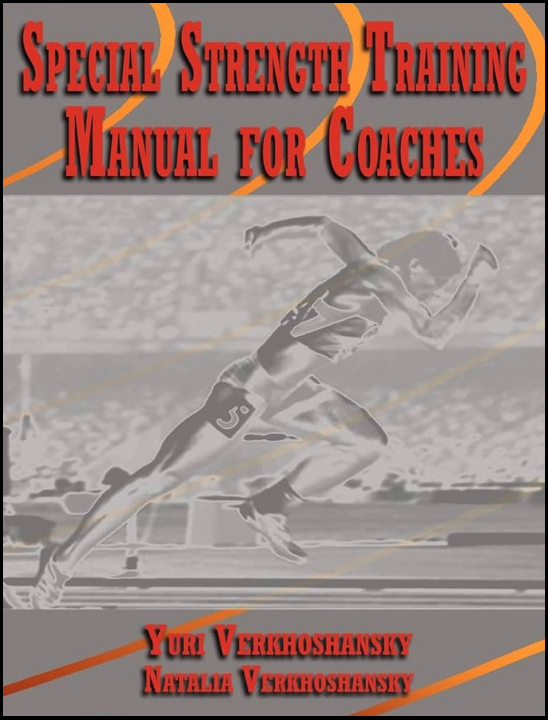
As someone with a keen interest in speed and power development, I was recommended several texts by Yuri Verkhoshansky. Best known for his “shock method” in plyometrics, his books include Supertraining, Shock Method and this Special Strength Training (SST) Manual. While the title suggests this is aimed at coaches, it’s simply because there’s so much practical application here that would benefit a coach. Despite only having myself to train, I found this to be an incredibly valuable resource for furthering my education and writing my own workouts.
This book contains a very thorough explanation for how to program speed or strength training across the year. Alongside the classic descriptions of rep ranges and percentages of 1RM, it outlines how you might progress each exercise across a training block of 6-8 weeks.
The final three chapters detail programs you could take away and use to improve in various sports. These include rowing, Olympic weightlifting, basketball, acceleration in sprinting and middle distance running. Despite the relatively heft price tag I consider this to be absolutely worth the money.

PRO TIP: Take notes! When you read a book, use a blank sheet of paper as a bookmark. Write down any interesting facts and information from the book. This condenses a whole book into 3-4 pages of key notes that are important and relevant to you.
My Notes on SST Manual for Coaches
Chapter 1: Methodological Foundations of SST
- A training process focused on improving sports results should focus on increasing power output
Basic strength capabilities can be split into four categories:
- Maximal Strength
- Explosive Strength
- Starting Strength
- Acceleration Strength
- The relevance of maximum strength to maximum speed of movement depends on the external resistance. The higher the resistance, the bigger role that maximal strength plays.
- Time economy (cutting rest periods) leads to a loss in training efficiency. Rest periods should be respected, and active rest utilised where possible. The lactate concentration reduces at a much faster rate if the same muscles are worked at a lower intensity (<75%) during the rest periods
Chapter 2: SST Means and Methods – Resistance Exercises
The two main groups of resistance exercises are:
Yuri Verkhoshansky, Special Strength Training Manual for Coaches
- Exercises which improve the sporting movement
- Exercises which allow the athlete to complete the exercises in 1. without injury
An example of the above in sprinting would be intense jumping (group 1), which should be preceded by exercises like back squats (group 2) to prepare the body to handle the jumps.
- The maximal effort method is used for the development of maximal and explosive strength without significant increases in muscle size. An example would be 2-4 sets of 2-3 reps at 90-95% 1RM with 4-6 minutes rest.
- The repeat-serial method is sub-maximal work intensity and volume, using the same number of sets and optimal rest periods. An example would be 2-3 series* of 3 sets at 80/90/93% 1RM with 2-4 minutes rest between sets and 6-8 minutes rest between series.
- The interval-serial method increases the power and capacity of energy supplying mechanisms. An example would be 2-3 series of 6-8 slow reps, 60 seconds rest, at 30-40% 1RM with 10-12 minutes rest between series.
- Isometric exercises are generally unsuitable for explosive sports. Strength mainly improves at the joint angle used in the exercise.
*In 18 years of strength training I had never come across the term “series” before. The idea is that instead of doing 3 sets of 6 with 4 minutes rest, you could double the workload by taking a larger break of 8-10 minutes, and then doing another 3 sets of 6.
Chapter 3: SST Means and Methods – Jump Exercises
Jump exercise hierarchy based on level of training stimuli:
- Jumping over boxes or hurdles
- Bounds
- Stadium Jumping
- Standing jumps (no forward displacement)
- Box Jumps
- Consecutive barbell split jumps
- Consecutive KB squat jumps (weight in middle, feet raised on platforms)
- Vertical jumps with barbell
- Depth jumps
- For box jumps or broad jumps, the repeat-serial method should be employed, sets of 8-10 jumps with arbitrary rest. This aids explosive and starting strength.
- Short bounding helps with 30m time, long bounding helps more with 60-100m time, especially from a flying start.
- Depth jumps should begin with 40-50cm and gradually work up to an optimal height of 75cm. No jump exercises should follow depth jumps due to their intensity.
Below is a video I recorded while following a program from chapter 7. This is a depth jump from 60cm with a ground contact time of 0.20 seconds.
Chapter 5: Organisation of SST in the Training Process
- The Long-lasting Delayed Training Effect is where a block of 6-12 weeks of concentrated strength loads cause a temporary strength deficit (ideally 10-12%) and after the end of the 6-12 week phase a mirrored 6-12 week phase of raised performance (+20-30%) occurs. It’s only suitable for high level athletes.
For speed-strength, the focus on consecutive training blocks should be:
- Increase maximal strength
- Increase explosive and starting strength
- Increase reactive ability
Chapters 6-8: SST in Acyclic/Cyclic/General Sports
These chapters contain some 6-8 week programs for various sports. This includes a 6 week “Russian Pyramid” for Olympic weightlifters, one for improving the first 30m in track & field sprinters, a program for Rowers, and one for explosive strength and reactive ability in American Football.
I personally followed the 30m sprint program and found it to be too advanced, though my 100m time is 11.9 seconds. It did, however, allow me to increase my squat by around 15kg compared to the previous season.

